[English] 日本語
 Yorodumi
Yorodumi- EMDB-34300: Cryo-EM structure of the human TRPC5 ion channel in lipid nanodis... -
+ Open data
Open data
- Basic information
Basic information
| Entry |  | |||||||||
|---|---|---|---|---|---|---|---|---|---|---|
| Title | Cryo-EM structure of the human TRPC5 ion channel in lipid nanodiscs, class2 | |||||||||
 Map data Map data | ||||||||||
 Sample Sample |
| |||||||||
 Keywords Keywords | transient receptor potential / METAL TRANSPORT | |||||||||
| Function / homology |  Function and homology information Function and homology informationregulation of membrane hyperpolarization / phosphatidylserine exposure on apoptotic cell surface / negative regulation of dendrite morphogenesis / Role of second messengers in netrin-1 signaling / store-operated calcium channel activity / inositol 1,4,5 trisphosphate binding / cation channel complex / actinin binding / clathrin binding / TRP channels ...regulation of membrane hyperpolarization / phosphatidylserine exposure on apoptotic cell surface / negative regulation of dendrite morphogenesis / Role of second messengers in netrin-1 signaling / store-operated calcium channel activity / inositol 1,4,5 trisphosphate binding / cation channel complex / actinin binding / clathrin binding / TRP channels / regulation of cytosolic calcium ion concentration / positive regulation of axon extension / positive regulation of neuron differentiation / calcium channel complex / calcium ion transmembrane transport / calcium channel activity / neuron differentiation / calcium ion transport / nervous system development / presynapse / actin binding / growth cone / positive regulation of cytosolic calcium ion concentration / ATPase binding / neuron apoptotic process / neuronal cell body / positive regulation of cell population proliferation / dendrite / plasma membrane Similarity search - Function | |||||||||
| Biological species |  Homo sapiens (human) Homo sapiens (human) | |||||||||
| Method | single particle reconstruction / cryo EM / Resolution: 3.59 Å | |||||||||
 Authors Authors | Won J / Jeong H / Lee HH | |||||||||
| Funding support |  Korea, Republic Of, 1 items Korea, Republic Of, 1 items
| |||||||||
 Citation Citation |  Journal: Nat Commun / Year: 2023 Journal: Nat Commun / Year: 2023Title: Molecular architecture of the Gα-bound TRPC5 ion channel. Authors: Jongdae Won / Jinsung Kim / Hyeongseop Jeong / Jinhyeong Kim / Shasha Feng / Byeongseok Jeong / Misun Kwak / Juyeon Ko / Wonpil Im / Insuk So / Hyung Ho Lee /   Abstract: G-protein coupled receptors (GPCRs) and ion channels serve as key molecular switches through which extracellular stimuli are transformed into intracellular effects, and it has long been postulated ...G-protein coupled receptors (GPCRs) and ion channels serve as key molecular switches through which extracellular stimuli are transformed into intracellular effects, and it has long been postulated that ion channels are direct effector molecules of the alpha subunit of G-proteins (Gα). However, no complete structural evidence supporting the direct interaction between Gα and ion channels is available. Here, we present the cryo-electron microscopy structures of the human transient receptor potential canonical 5 (TRPC5)-Gα complexes with a 4:4 stoichiometry in lipid nanodiscs. Remarkably, Gα binds to the ankyrin repeat edge of TRPC5 ~ 50 Å away from the cell membrane. Electrophysiological analysis shows that Gα increases the sensitivity of TRPC5 to phosphatidylinositol 4,5-bisphosphate (PIP), thereby rendering TRPC5 more easily opened in the cell membrane, where the concentration of PIP is physiologically regulated. Our results demonstrate that ion channels are one of the direct effector molecules of Gα proteins triggered by GPCR activation-providing a structural framework for unraveling the crosstalk between two major classes of transmembrane proteins: GPCRs and ion channels. | |||||||||
| History |
|
- Structure visualization
Structure visualization
| Supplemental images |
|---|
- Downloads & links
Downloads & links
-EMDB archive
| Map data |  emd_34300.map.gz emd_34300.map.gz | 230 MB |  EMDB map data format EMDB map data format | |
|---|---|---|---|---|
| Header (meta data) |  emd-34300-v30.xml emd-34300-v30.xml emd-34300.xml emd-34300.xml | 18.6 KB 18.6 KB | Display Display |  EMDB header EMDB header |
| Images |  emd_34300.png emd_34300.png | 188 KB | ||
| Filedesc metadata |  emd-34300.cif.gz emd-34300.cif.gz | 6.6 KB | ||
| Others |  emd_34300_half_map_1.map.gz emd_34300_half_map_1.map.gz emd_34300_half_map_2.map.gz emd_34300_half_map_2.map.gz | 226.5 MB 226.6 MB | ||
| Archive directory |  http://ftp.pdbj.org/pub/emdb/structures/EMD-34300 http://ftp.pdbj.org/pub/emdb/structures/EMD-34300 ftp://ftp.pdbj.org/pub/emdb/structures/EMD-34300 ftp://ftp.pdbj.org/pub/emdb/structures/EMD-34300 | HTTPS FTP |
-Validation report
| Summary document |  emd_34300_validation.pdf.gz emd_34300_validation.pdf.gz | 859.5 KB | Display |  EMDB validaton report EMDB validaton report |
|---|---|---|---|---|
| Full document |  emd_34300_full_validation.pdf.gz emd_34300_full_validation.pdf.gz | 859 KB | Display | |
| Data in XML |  emd_34300_validation.xml.gz emd_34300_validation.xml.gz | 16.1 KB | Display | |
| Data in CIF |  emd_34300_validation.cif.gz emd_34300_validation.cif.gz | 19.1 KB | Display | |
| Arichive directory |  https://ftp.pdbj.org/pub/emdb/validation_reports/EMD-34300 https://ftp.pdbj.org/pub/emdb/validation_reports/EMD-34300 ftp://ftp.pdbj.org/pub/emdb/validation_reports/EMD-34300 ftp://ftp.pdbj.org/pub/emdb/validation_reports/EMD-34300 | HTTPS FTP |
-Related structure data
| Related structure data | 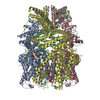 8gvwMC 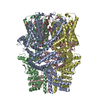 7x6cC 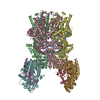 7x6iC 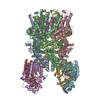 8gvxC M: atomic model generated by this map C: citing same article ( |
|---|---|
| Similar structure data | Similarity search - Function & homology  F&H Search F&H Search |
- Links
Links
| EMDB pages |  EMDB (EBI/PDBe) / EMDB (EBI/PDBe) /  EMDataResource EMDataResource |
|---|---|
| Related items in Molecule of the Month |
- Map
Map
| File |  Download / File: emd_34300.map.gz / Format: CCP4 / Size: 244.1 MB / Type: IMAGE STORED AS FLOATING POINT NUMBER (4 BYTES) Download / File: emd_34300.map.gz / Format: CCP4 / Size: 244.1 MB / Type: IMAGE STORED AS FLOATING POINT NUMBER (4 BYTES) | ||||||||||||||||||||||||||||||||||||
|---|---|---|---|---|---|---|---|---|---|---|---|---|---|---|---|---|---|---|---|---|---|---|---|---|---|---|---|---|---|---|---|---|---|---|---|---|---|
| Projections & slices | Image control
Images are generated by Spider. | ||||||||||||||||||||||||||||||||||||
| Voxel size | X=Y=Z: 1.086 Å | ||||||||||||||||||||||||||||||||||||
| Density |
| ||||||||||||||||||||||||||||||||||||
| Symmetry | Space group: 1 | ||||||||||||||||||||||||||||||||||||
| Details | EMDB XML:
|
-Supplemental data
-Half map: #1
| File | emd_34300_half_map_1.map | ||||||||||||
|---|---|---|---|---|---|---|---|---|---|---|---|---|---|
| Projections & Slices |
| ||||||||||||
| Density Histograms |
-Half map: #2
| File | emd_34300_half_map_2.map | ||||||||||||
|---|---|---|---|---|---|---|---|---|---|---|---|---|---|
| Projections & Slices |
| ||||||||||||
| Density Histograms |
- Sample components
Sample components
-Entire : Transient receptor potential
| Entire | Name: Transient receptor potential |
|---|---|
| Components |
|
-Supramolecule #1: Transient receptor potential
| Supramolecule | Name: Transient receptor potential / type: complex / ID: 1 / Parent: 0 / Macromolecule list: #1 |
|---|---|
| Source (natural) | Organism:  Homo sapiens (human) Homo sapiens (human) |
-Macromolecule #1: Short transient receptor potential channel 5
| Macromolecule | Name: Short transient receptor potential channel 5 / type: protein_or_peptide / ID: 1 Details: reisdues 766,777(SR) restriction enzyme site, XbaI, residues 768-773(LEVLFQ) protease cleavage site, HRV-3C Number of copies: 4 / Enantiomer: LEVO |
|---|---|
| Source (natural) | Organism:  Homo sapiens (human) Homo sapiens (human) |
| Molecular weight | Theoretical: 89.951891 KDa |
| Recombinant expression | Organism:  Homo sapiens (human) Homo sapiens (human) |
| Sequence | String: MAQLYYKKVN YSPYRDRIPL QIVRAETELS AEEKAFLNAV EKGDYATVKQ ALQEAEIYYN VNINCMDPLG RSALLIAIEN ENLEIMELL LNHSVYVGDA LLYAIRKEVV GAVELLLSYR RPSGEKQVPT LMMDTQFSEF TPDITPIMLA AHTNNYEIIK L LVQKRVTI ...String: MAQLYYKKVN YSPYRDRIPL QIVRAETELS AEEKAFLNAV EKGDYATVKQ ALQEAEIYYN VNINCMDPLG RSALLIAIEN ENLEIMELL LNHSVYVGDA LLYAIRKEVV GAVELLLSYR RPSGEKQVPT LMMDTQFSEF TPDITPIMLA AHTNNYEIIK L LVQKRVTI PRPHQIRCNC VECVSSSEVD SLRHSRSRLN IYKALASPSL IALSSEDPIL TAFRLGWELK ELSKVENEFK AE YEELSQQ CKLFAKDLLD QARSSRELEI ILNHRDDHSE ELDPQKYHDL AKLKVAIKYH QKEFVAQPNC QQLLATLWYD GFP GWRRKH WVVKLLTCMT IGFLFPMLSI AYLISPRSNL GLFIKKPFIK FICHTASYLT FLFMLLLASQ HIVRTDLHVQ GPPP TVVEW MILPWVLGFI WGEIKEMWDG GFTEYIHDWW NLMDFAMNSL YLATISLKIV AYVKYNGSRP REEWEMWHPT LIAEA LFAI SNILSSLRLI SLFTANSHLG PLQISLGRML LDILKFLFIY CLVLLAFANG LNQLYFYYET RAIDEPNNCK GIRCEK QNN AFSTLFETLQ SLFWSVFGLL NLYVTNVKAR HEFTEFVGAT MFGTYNVISL VVLLNMLIAM MNNSYQLIAD HADIEWK FA RTKLWMSYFD EGGTLPPPFN IIPSPKSFLY LGNWFNNTFC PKRDPDGRRR RRNLRSFTER NADSLIQNQH YQEVIRNL V KRYVAAMIRN SKTHEGLTEE NFKELKQDIS SFRYEVLDLL GNRKSRLEVL FQ UniProtKB: Short transient receptor potential channel 5 |
-Macromolecule #2: PHOSPHATIDYLETHANOLAMINE
| Macromolecule | Name: PHOSPHATIDYLETHANOLAMINE / type: ligand / ID: 2 / Number of copies: 4 / Formula: PTY |
|---|---|
| Molecular weight | Theoretical: 734.039 Da |
| Chemical component information | 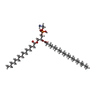 ChemComp-PTY: |
-Macromolecule #3: (2S)-3-(hexadecanoyloxy)-2-[(9Z)-octadec-9-enoyloxy]propyl 2-(tri...
| Macromolecule | Name: (2S)-3-(hexadecanoyloxy)-2-[(9Z)-octadec-9-enoyloxy]propyl 2-(trimethylammonio)ethyl phosphate type: ligand / ID: 3 / Number of copies: 4 / Formula: POV |
|---|---|
| Molecular weight | Theoretical: 760.076 Da |
| Chemical component information |  ChemComp-POV: |
-Macromolecule #4: CHOLESTEROL HEMISUCCINATE
| Macromolecule | Name: CHOLESTEROL HEMISUCCINATE / type: ligand / ID: 4 / Number of copies: 4 / Formula: Y01 |
|---|---|
| Molecular weight | Theoretical: 486.726 Da |
| Chemical component information |  ChemComp-Y01: |
-Macromolecule #5: ZINC ION
| Macromolecule | Name: ZINC ION / type: ligand / ID: 5 / Number of copies: 4 / Formula: ZN |
|---|---|
| Molecular weight | Theoretical: 65.409 Da |
-Macromolecule #6: CALCIUM ION
| Macromolecule | Name: CALCIUM ION / type: ligand / ID: 6 / Number of copies: 4 / Formula: CA |
|---|---|
| Molecular weight | Theoretical: 40.078 Da |
-Macromolecule #7: (2S)-2-(hexadecanoyloxy)-3-hydroxypropyl (9Z)-octadec-9-enoate
| Macromolecule | Name: (2S)-2-(hexadecanoyloxy)-3-hydroxypropyl (9Z)-octadec-9-enoate type: ligand / ID: 7 / Number of copies: 4 / Formula: YZY |
|---|---|
| Molecular weight | Theoretical: 594.949 Da |
| Chemical component information |  ChemComp-YZY: |
-Experimental details
-Structure determination
| Method | cryo EM |
|---|---|
 Processing Processing | single particle reconstruction |
| Aggregation state | particle |
- Sample preparation
Sample preparation
| Buffer | pH: 8 |
|---|---|
| Vitrification | Cryogen name: ETHANE |
- Electron microscopy
Electron microscopy
| Microscope | TFS GLACIOS |
|---|---|
| Image recording | Film or detector model: FEI FALCON IV (4k x 4k) / Average electron dose: 40.0 e/Å2 |
| Electron beam | Acceleration voltage: 200 kV / Electron source:  FIELD EMISSION GUN FIELD EMISSION GUN |
| Electron optics | Illumination mode: FLOOD BEAM / Imaging mode: BRIGHT FIELD / Nominal defocus max: 2.0 µm / Nominal defocus min: 1.0 µm |
 Movie
Movie Controller
Controller


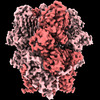





 Z (Sec.)
Z (Sec.) Y (Row.)
Y (Row.) X (Col.)
X (Col.)





































